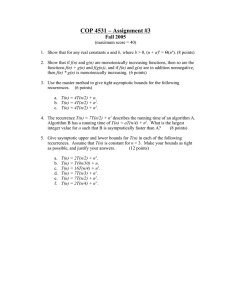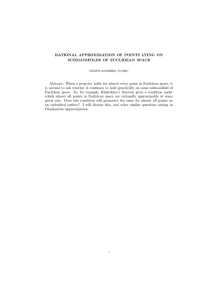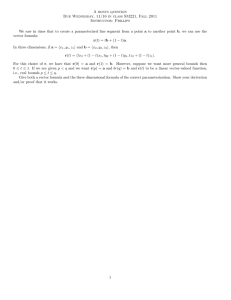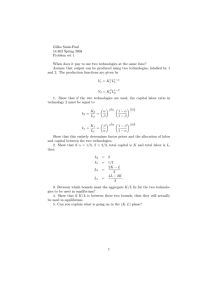On Asymptotic Elias Bound Euclidean Space Codes over for
advertisement
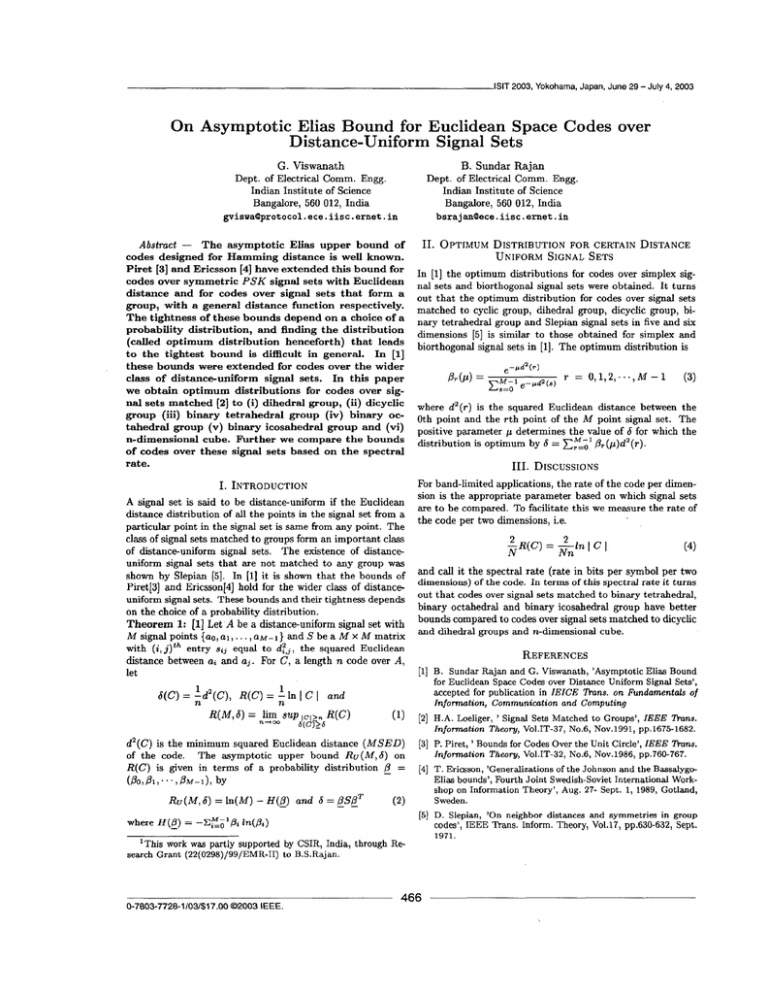
lSlT 2003,Yokohama, Japan, June 29 -July 4, 2003
On Asymptotic Elias Bound for Euclidean Space Codes over
Distance-Uniform Signal Sets
G. Viswanath
Dept. of Electrical Comm. Engg.
Indian Institute of Science
Bangalore, 560 012, India
gvisva(0protocol.ece.iisc.ernet.in
Abstract - The asymptotic Elias upper bound of
codes designed for Hamming distance is well known.
Piret [3] and Ericsson [4] have extended this bound for
codes over symmetric PSK signal sets with Euclidean
distance and for codes over signal sets that form a
group, with a general distance function respectively.
The tightness of these bounds depend on a choice of a
probability distribution, and finding the distribution
(called optimum distribution henceforth) that leads
to the tightest bound is difflcult in general. In [l]
these bounds were extended for codes over the wider
class of distance-uniform signal sets. In this paper
we obtain optimum distributions for codes over signal sets matched [2] to (i) dihedral group, (ii) dicyclic
group (iii) binary tetrahedral group (iv) binary octahedral group (v) binary icosahedral group and (vi)
n-dimensional cube. F'urther we compare the bounds
of codes over these signal sets based on the spectral
rate.
I. INTRODUCTION
A signal set is said t o be distanceuniform if the Euclidean
distance distribution of all the points in the signal set from a
particular point in the signal set is same from any point. The
class of signal sets matched t o groups form an important class
of distanceuniform signal sets. The existence of distance
uniform signal sets that are not matched t o any group was
shown by Slepian [5]. In [I] it is shown that the bounds of
Piret[J] and Ericsson[4] hold for the wider class of distanceuniform signal sets. These bounds and their tightness depends
on the choice of a probability distribution.
Theorem 1: [l]Let A be a distance-uniform signal set with
M signal points {ao, a l l . .. ,U M - ~ }and S be a M x M matrix
with ( i , j ) t hentry sij equal to d?,j, the squared Euclidean
distance between a; and a j . For C, a length n code over A,
let
d 2 ( C )is the minimum squared Euclidean distance ( M S E D )
of the code. The asymptotic upper bound R o ( M , S ) on
R ( C ) is given in terms of a probability distribution
=
(BOlB11.
.. ,811.1-11by
,
Ru(M,6)
= ln(M) - H ( g ) and 6 =@SET
(2)
where N ( P ) = -Cgi'Pi ln(Pi)
'This work was partly supported by CSIR, India, through Research Grant (22(0298)/99/EMR-I1) to B.S .Rajan.
B. Sundar Rajan
Dept. of Electrical Comm. Engg.
Indian Institute of Science
Bangalore, 560 012, India
bsrajan@ece.iisc.ernet.in
11. OPTIMUM
DISTRIBUTION
FOR
CERTAIN
DISTANCE
UNIFORMSIGNAL
SETS
In [l] the optimum distributions for codes over simplex signal sets and biorthogonal signal sets were obtained. It turns
out that the optimum distribution for codes over signal sets
matched to cyclic group, dihedral group, dicyclic group, binary tetrahedral group and Slepian signal sets in five and six
dimensions [5] is similar to those obtained for simplex and
biorthogonal signal sets in [l].The optimum distribution is
-Md2
B 7 ( A = &1
(7)
e-MLda(8)
T
= 0,1,2,...,M-l
(3)
where d2(r) is the squared Euclidean distance between the
0th point and the Tth point of the M point signal set. The
positive parameter p determines the value of 6 for which the
PT(p)d2(r).
distribution is optimum by 6 = E,"=;;'
111. DISCUSSIONS
For band-limited applications, the rate of the code per dimension is the appropriate parameter based on which signal sets
are t o be compared. To facilitate this we measure the rate of
the code per two dimensions, i.e.
2
2
z R ( C ) = --In
Nn
IC I
(4)
and call it the spectral rate (rate in bits per symbol per two
dimensions) of the code. In terms of this spectral rate it turns
out that codes over signal sets matched to binary tetrahedral,
binary octahedral and binary icosahedral group have better
bounds compared to codes over signal sets matched t o dicyclic
and dihedral groups and n-dimensional cube.
REFERENCES
B. Sundar Rajan and G. Viswanath, 'Asymptotic Elias Bound
for Euclidean Space Codes over Distance Uniform Signal Sets',
accepted for publication in IEICE %ns. o n Fundamentals of
Information, Communication and Computing
H.A. Loeliger, ' Signal Sets Matched to Groups', IEEE %ns.
Informotion Theory, Vol.IT-37, No.6, Nov.1991, pp.1675-1682.
P. Piret, ' Bounds for Codes Over the Unit Circle', IEEE %ns.
Information Theory, Vol.IT-32, No.6, Nov.1986, pp.760-767.
T. Eridsson, 'Generalizations of the Johnson and the BassalygoElias bounds', Fourth Joint Swedish-Soviet International Workshop on Information Theory', Aug. 27- Sept. 1, 1989, Gotland,
Sweden.
D. Slepian, 'On neighbor distances and symmetries in group
codes', IEEE Trans. Inform. Theory, Vo1.17, pp.630-632, Sept.
1971.
